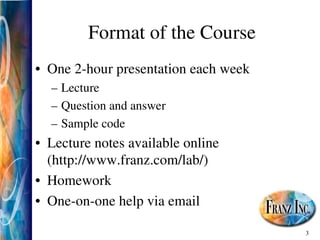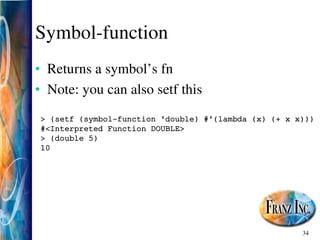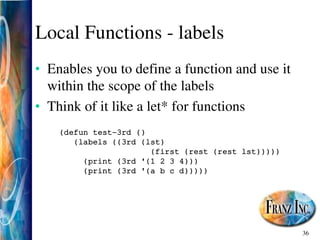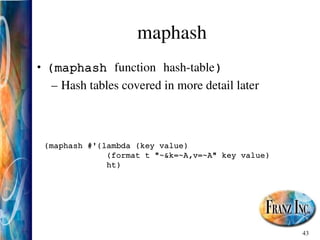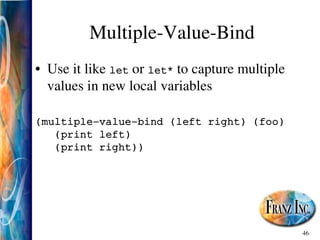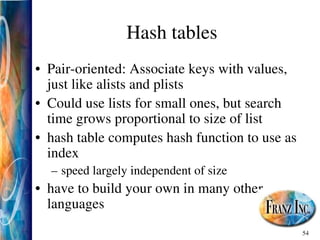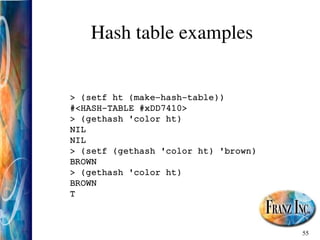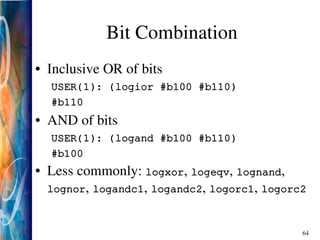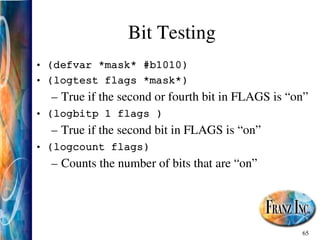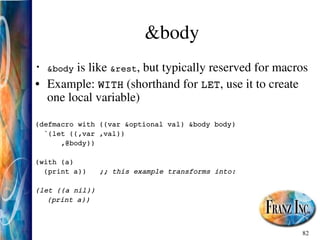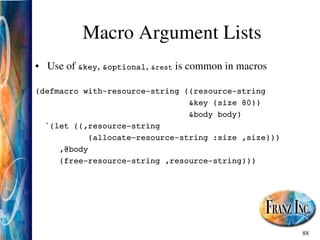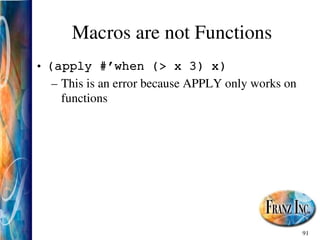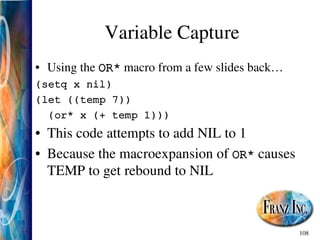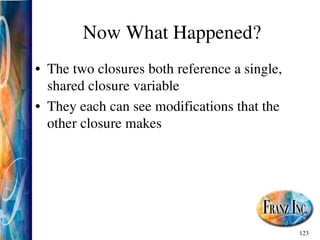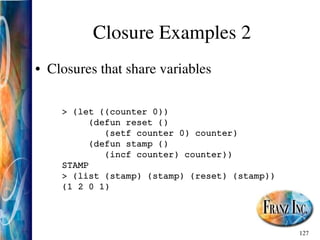Advanced features of Lisp functions Advanced features of Lisp functions
- 1. 1 Allegro CL Certification Program Lisp Programming Series Level 2
- 2. 2 Goals for Level 2 • Build on Level 1 – Assumes you can write functions, use the debugger, understand lists and list processing • Detailed Exposure To – Functions – Macros – Objectoriented programming
- 3. 3 Format of the Course • One 2hour presentation each week – Lecture – Question and answer – Sample code • Lecture notes available online (http://www.franz.com/lab/) • Homework • Oneonone help via email
- 4. 4 Session 1 (today) • Advanced features of Lisp functions • Structures, Hash Tables, Bits and Bytes • Macros • Closures
- 5. 5 Session 2 Common Lisp Object System (CLOS) • Top Ten things to do in CLOS • Classes, instances, and inheritance • Methods • Class precedence list • Programming style
- 6. 6 Session 3 • Performance considerations with CLOS • The garbage collector • Error conditions • Using the IDE to make Windows™ windows
- 7. 7 Homework • Lisp is best learnt by handson experience • Many exercises for each session • Will dedicate class time to reviewing exercises • Email instructor for oneonone assistance doing the homework or any other questions relevant to the class – [email protected]
- 8. 8 Getting Allegro Common Lisp • This class is based on version 6.2. • Trial version should be sufficient for this module – Download free from http://www.franz.com/ – Works for 60 days • I will be using ACL on Windows • You can use ACL on UNIX, but the development environment is different, and I won't be using it.
- 9. 9 Allegro CL Certification Program Lisp Programming Series Level 2 Session 2.1.1 Functions
- 10. 10 Ways to define functions • defun • lambda • flet • labels
- 11. 11 Defun (defun double (x) "Doubles the number" (declare (fixnum x)) (+ x x)) (defun fnname arglist optionaldocstring optionaldeclarations code)
- 12. 12 Argument List • Contains names for variables • that get their values from arguments provided in calls to the function • persist throughout the body of the function • are not typed • May contain optional and keyword arguments
- 13. 13 Keyword Arguments (defun printarraysize (array &key (stream *standardoutput*) UseGraphics) (let ((size (length array))) (if UseGraphics (drawsize size stream) ; then (print size stream)) ; else size))) • Call the function like this: – (printarraysize *myarray*) • Or like this: – (printarraysize *myarray* :stream myopenfile)
- 14. 14 Keyword Arguments • Call the function with any number of the keyword arguments, in any order • Arguments specified as name/value pairs – :stream myopenfile • Costs a couple microseconds – Because Lisp must parse the argument list • Use when some arguments are only rarely needed – Source code in callers is greatly simplified • Or when different calls will need different groups of arguments
- 15. 15 Keyword Detail &key (stream *standardoutput*) UseGraphics • &key specifies the arguments that follow are keyword arguments • Each argument can either be a twoelement list, a threeelement list, or a single symbol – Threeelement list is used for suppliedp arguments, described later on • Default value of an argument, when not passed by the caller, is the second element of the twoelement list, or NIL if not otherwise specified
- 16. 16 Optional Arguments (defun printarraysize (array &optional (stream *standardoutput*) UseGraphics) (let ((size (length array))) (if UseGraphics (drawsize size stream) ; then (print size stream)) ; else size))) • Call the function like this: – (printarraysize *myarray*) • Or like this: – (printarraysize *myarray* myopenfile)
- 17. 17 Optional Arguments • Call the function with any number of the optional arguments • Lisp determines which one is which by position – To specify the second optional argument, you must always specify the first as well • Costs a couple microseconds – Because Lisp must parse the argument list • Use when some arguments are only rarely needed, and when there aren't very many of them – Source code in callers is greatly simplified
- 18. 18 Other possibilities (defun incr (n &optional inc) ;; if the value of inc was not specified, ;; or if it was specified but not a number, ;; then set it to 1. (if (not (numberp inc)) (setq inc 1)) (+ n inc)) (defun incr (n &optional (inc 1 incrementp)) ;; incrementp TRUE when argument was specified ;; by caller (if (and incrementp (not (numberp inc))) (print "nonnumeric increment")) (+ n inc))
- 19. 19 Optional and Keyword Arguments • Ways to specify the argument • <name> defaults to nil • (<name> <default value>) • (<name> <default value> <suppliedp>) • Use optionals for small numbers of non required arguments that are easy to remember • Use keywords with either large numbers of nonrequired arguments or ones that are hard to remember
- 20. 20 &rest example (defun add (&rest numbers) (let ((sum 0)) (dolist (n numbers) (setq sum (+ sum n))) sum)) • Call it this way: • (add 1 2 4) • Or this way: • (add 9 1 8 4 8 6)
- 21. 21 &rest Arguments • Caller may pass any number of arguments, there is no limit • Lisp combines all the arguments into a single list • Needed only rarely • Generally used when all the arguments have the same type and will participate equally in the operation
- 22. 22 Pointers to Functions • The usual way of calling a function: – (+ 3 4) • Alternative way: – (funcall #'+ 3 4) • #'+ is a pointer to the function "+" • Function pointers can be passed as arguments, returned from functions, or stored as data
- 23. 23 Pointers to Functions • #’add – Is a reference to the function named ADD (defun combiner (n) (if (typep n 'list) #'list #'+)) ;; Example of returning a function pointer ;; from a function. (setq *combiner* (combiner 3))
- 24. 24 Calling a Function by its Pointer • #'+ – #<FUNCTION +> • (funcall #'+ 3 4 5 6) – 18 • (apply #'+ (list 3 4 5 6)) – 18
- 25. 25 Using Function References • Functions can be used just like any other type object (defun combiner (x) (typecase x (number #'+) (list #'append) (t #'list))) COMBINER USER(49): (defun combine (&rest args) (apply (combiner (first args)) args)) COMBINE USER(50): (combine 2 3) 5 USER(51): (combine '(a b) '(c d)) (A B C D) USER(54): (combine 'a 'b 'c) (A B C)
- 26. 26 Function References • Commonly used in sorting routines – (sort '(5 1 4 6) #'<) – #'< small numbers first – #'> big numbers first – #'string< A before Z – #'string> Z before A • Often used when mapping over a collection (vector, list, hash table, etc.) – (mapcar #'print '(5 1 4 6))
- 27. 27 Lambdas • Nameless fns • (setq function #'(lambda (x y) (* x y))) • (setq function #'(lambda (x y) (+ x y))) • (funcall function 3 4)
- 28. 28 Lambda Example • Example (defun incrementall (&rest numbers) (mapcar #'(lambda (x) (+ x 1)) numbers)) • (incrementall 5 6 7 8) • (6 7 8 9)
- 29. 29 Where do you use lambdas • When a function will have only one caller and it is relatively trivial • Saves using up you namespace • Seeing the code in place may improve readability in some situations • Commonly used with mapping functions
- 30. 30 Other Functions of Functions • Many tools available to investigate your environment
- 31. 31 fboundp • Determines if a symbol is associated with a function definition or function binding (fboundp 'double) #<Interpreted Function DOUBLE>
- 32. 32 fdefinition • (fdefinition '+) retrieves the function object associated with the argument. Same as symbolfunction for symbols, but also works on names that are lists (such as (setf foo)). • Functionlambdaexpression retrieves the definition, if it is available (but the argument must be a function object, not a function name)
- 33. 33 fmakunbound • (fmakunbound 'add) • makes the function named ADD become undefined • analogous to makunbound for variables
- 34. 34 Symbolfunction • Returns a symbol’s fn • Note: you can also setf this > (setf (symbolfunction 'double) #'(lambda (x) (+ x x))) #<Interpreted Function DOUBLE> > (double 5) 10
- 35. 35 Global .vs. Local Functions • Defun’s are global • Lambda’s can only be used in place unless the are assigned or stored on something • flets and labels can be used to create fns that are only available in a local context
- 36. 36 Local Functions labels • Enables you to define a function and use it within the scope of the labels • Think of it like a let* for functions (defun test3rd () (labels ((3rd (lst) (first (rest (rest lst))))) (print (3rd '(1 2 3 4))) (print (3rd '(a b c d)))))
- 37. 37 SETF Functions • setf is useful when you have a pair of operations for getting and setting a value • In other languages, you would name the pair Getxxx and Setxxx • With setf, you have only one name • (first list) ; gets first element of list • (setf (first list) 17) ; sets first element to 17
- 38. 38 SETF Function Definition ;;; Get the first element (defun 1st (list) (car list)) ;;; Set the first element (defun (setf 1st) (new list) (rplaca list new) new)
- 39. 39 Using SETF (setq a '(one two three)) (1st a) > ONE (setf (1st a) 1) > 1 (1st a) > 1 a > (1 two three)
- 40. 40 Many Operations in Lisp itself are setfenabled • first, second, third, last, nth, elt • aref, fillpointer • Elements or fields of a structure • Elements or slots of a CLOS instance • symbolvalue, symbolfunction • gethash
- 41. 41 The Idea of Mapping Functions • You pass a “pointer to a function” as one of the arguments • The “pointer to a function” is applied to each element of a collection • The results of the individual calls may be collected up into a list
- 42. 42 mapcar • (mapcar fn list &rest morelists) • Example: > (mapcar #'print '(a b c)) A B C (A B C) > (mapcar #'cons '(a b c) '(1 2 3)) ((A . 1) (B . 2) (C . 3))
- 43. 43 maphash • (maphash function hashtable) – Hash tables covered in more detail later (maphash #'(lambda (key value) (format t "~&k=~A,v=~A" key value) ht)
- 44. 44 The Idea of Multiple Values • Sometimes you want a function to return more than one value • Option 1: Make an object that contains the values – (defun foo () (list 1 2)) • Option 2: Use Lisp multiple values – (defun foo () (values 1 2)) – 1 is said to be the “first value” – 2 is said to be the “second value”
- 45. 45 multiplevaluesetq • Use it like setq to capture multiple values (let ((x 0)(y 0)) (print x) (print y) ; values before (multiplevaluesetq (x y) (foo)) (print x) (print y) ; values after )
- 46. 46 MultipleValueBind • Use it like let or let* to capture multiple values in new local variables (multiplevaluebind (left right) (foo) (print left) (print right))
- 47. 47 Allegro CL Certification Program Lisp Programming Series Level 2 Session 2.1.2 Structures and Hash Tables
- 48. 48 Userdefined structures • Can either use CLOS instances or defstructs – both store data in a userdefined form – instances can have behavior in addition – defstructs are more efficient, but less powerful • Designed to look similar in code – slot references look like function calls – can switch between them during development
- 49. 49 Structures • Define with defstruct • create one with (make<name> …) • access slot with <name><slotname> > (defstruct routesegment nodenumber start end) ROUTESEGMENT > (setf rs (makeroutesegment :nodenumber 5 :start 2 :end 7)) #S(ROUTESEGMENT NODENUMBER 5 START 2 END 7) > (routesegmentstart rs) 2
- 50. 50 defstruct with default values • Example > (defstruct point (x 0) (y 0)) POINT > (setf pt (makepoint)) #S(POINT X 0 Y 0)
- 51. 51 Structures • Standard Lisp Structures are really just vectors. • Accessing an element of a structure is as fast as accessing an element of an array. • The reader functions generated by defstruct get compiled into an vector access of a specific position (fast!) • If you redefine the positions, you have to recompile your code
- 52. 52 defstruct with type • Example > (defstruct (point (:type list)) (x 0) (y 0)) POINT > (setf pt (makepoint :x 10 :y 20)) (10 20)
- 53. 53 defstruct with type and name • Example > (defstruct (point (:type list) (:named t)) (x 0) (y 0)) POINT > (setf pt (makepoint :x 10 :y 20)) (POINT 10 20)
- 54. 54 Hash tables • Pairoriented: Associate keys with values, just like alists and plists • Could use lists for small ones, but search time grows proportional to size of list • hash table computes hash function to use as index – speed largely independent of size • have to build your own in many other languages
- 55. 55 Hash table examples > (setf ht (makehashtable)) #<HASHTABLE #xDD7410> > (gethash 'color ht) NIL NIL > (setf (gethash 'color ht) 'brown) BROWN > (gethash 'color ht) BROWN T
- 56. 56 gethash’s Multiple values • gethash returns two values – value associated with key or NIL – Whether or not the value was found • Second value helps you distinguish between – NIL as the value of the key – NIL as the value you get when the key has no value
- 57. 57 Hash Table Fns • Examples > (hashtablep ht) (#<STRUCTURECLASS HASHTABLE #x891668>) > (gethash 'color ht) BROWN T > (remhash 'color ht) T > (gethash 'color ht) NIL NIL
- 58. 58 clrhash • Examples: (setf ht (makehashtable)) #<HASHTABLE #xE02D8C> > (setf (gethash 'color ht) 'brown) BROWN > (gethash 'color ht) BROWN T > (clrhash ht) #<HASHTABLE #xDD8280>
- 59. 59 Hash table iteration example (let ((test (makehashtable))) (setf (gethash 'a test) "This is the a value") (setf (gethash 'b test) "This is the b value") (maphash #’(lambda (sym str) (format t "~&~A = ~S" sym str)) test)) B = "This is the b value" A = "This is the a value" NIL
- 60. 60 maphash • Iterate over the contents of the hash table, pair by pair • (maphash #'(lambda (key value) ..code..) hash)
- 61. 61 Allegro CL Certification Program Lisp Programming Series Level 2 Session 2.1.3 Bits and Bytes
- 62. 62 Bits and Bytes • Normally represented as lisp integers • Often used for efficiency – Speed: some operations may compile into a single machine instruction – Size: a bit vector is much smaller than a general vector • Often used in combination with foreign function calls – Arguments to C++ and WIN32 libraries are often several "flags" passed as a single integer
- 63. 63 Bits of Integers • The #b prefix means a binary notation USER(1): #b10 2 ; decimal integer 2 USER(2): *printbase* 10 ; numbers normally print in decimal USER(3): (let ((*printbase* 2)) (print #b10) nil) 10 ; decimal integer 2 printed in binary NIL USER(4):
- 64. 64 Bit Combination • Inclusive OR of bits USER(1): (logior #b100 #b110) #b110 • AND of bits USER(1): (logand #b100 #b110) #b100 • Less commonly: logxor, logeqv, lognand, lognor, logandc1, logandc2, logorc1, logorc2
- 65. 65 Bit Testing • (defvar *mask* #b1010) • (logtest flags *mask*) – True if the second or fourth bit in FLAGS is “on” • (logbitp 1 flags ) – True if the second bit in FLAGS is “on” • (logcount flags) – Counts the number of bits that are “on”
- 66. 66 Byte Manipulation with ldb • USER(1): (setq flags #b111000111) • USER(2): (ldb (byte 4 0) flags) • #b0111 ; lowest (rightmost) four bits • USER(3): (ldb (byte 4 4) flags) • #b1100 ; next four bits • USER(4): (ldb (byte 8 0) flags) • #b11000111 ; lowest eight bits
- 67. 67 Byte Manipulation USER(5): (setf (ldb (byte 4 4) flags) #b0011) USER(6): flags #b100110111 • This line modifies the second four bits of the bit field.
- 68. 68 Shift Operation • ash arithmetic shift (left) – (ash 1 10) > 1024 – (ash 255 6) > 3 • Note that there is no assumption of integer size. You eventually get a bignum if you keep shifting left.
- 69. 69 How Many Bits? • (integerlength #b1000) => 4 • Use it to print a binary number: (defun binarytostring (bits) (let* ((L (integerlength bits)) (string (makestring L :initialelement #0))) (dotimes (I L) ;; Note that bit zero is on the right ;; of the string (character L1). (when (logbitp ( L I 1) bits) (setf (char string I) #1))) string))
- 70. 70 Vectors of Bits (setq vector (makearray 1024 :elementtype ‘bit :initialelement 0)) ;; Access and modify as any vector or array (setf (aref vector 0) 1) ;; But elements must be either zero or one (setf (aref vector 0) 2) ; ERROR
- 71. 71 Allegro CL Certification Program Lisp Programming Series Level 2 Session 2.1.4 Macros
- 72. 72 What are Macros? • Macros take lisp code as input and return lisp code as output. For example, When evaluating: (incf x) Evaluate this instead: (setf x (+ 1 x)) (defmacro incf (place) (list 'setf place (list '+ 1 place)))
- 73. 73 Macroexpansion • When the evaluator sees (incf a) – It notices that INCF names a macro – It “runs” or macroexpands the macro, which transforms the line of code into: • (setf a (+ 1 a)) – It evaluates that expression instead – So when you type (incf a) to the lisp listener, it is as if you had typed (setf a (+ 1 a))
- 74. 74 Macro Evaluation is Different • for functions – gets the function name – evaluates all the args – applies the function to the eval’ed args • for macros – passes arguments without evaluating them – the macro function returns another expression – evaluator evaluates that expression instead of the original
- 75. 75 Recursive Macros • Macros can macroexpand into other macros • For example – WHEN macroexpands into COND – COND macroexpands into IF • The evaluator (and the compiler) recursively macroexpand an expression until there are no more macros left
- 76. 76 Macroexpand function • macroexpand is function which lisp uses to call macro function and get result – it keeps recursively macroexpanding till no macros are left • macroexpand1 just does one step of macroexpansion • (macroexpand1 '(incf x)) – (setq x (+ x 1))
- 77. 77 macro functions • stored in same function cell of symbol • stored in a different format so that the system can tell it is a macro function • macrofunction <symbol> will return nil if the symbol has a normal function definition or none, but will return the expansion function if the symbol names a macro
- 78. 78 Macro Examples • Macros are just functions that transform expressions • Use macroexpand1 to see definition > (defmacro nil! (x) (list 'setf x nil)) NIL! > (setq x 5) 5 > (nil! x) NIL > x NIL > (macroexpand1 '(nil! x)) (SETF X NIL)
- 79. 79 Backquote • Used extensively in macros • Used by itself is equivalent to quote • Protects args from evaluation • comma (,) will unprotect > (setq a 1 b 2) 2 > `(a is ,a b is ,b) (A IS 1 B IS 2)
- 80. 80 Backquote example (defmacro incf (place) `(setf ,place (+ 1 ,place))) • Compared to earlier definition of INCF, this version is shorter, more concise, and easier to understand (but equivalent) (defmacro incf (place) (list 'setf place (list '+ 1 place)))
- 81. 81 ,@ • Like comma but splices in list > (setq lst '(1 2 3 4)) (1 2 3 4) > `(here are the numbers ,@lst) (HERE ARE THE NUMBERS 1 2 3 4)
- 82. 82 &body • &body is like &rest, but typically reserved for macros • Example: WITH (shorthand for LET, use it to create one local variable) (defmacro with ((var &optional val) &body body) `(let ((,var ,val)) ,@body)) (with (a) (print a)) ;; this example transforms into: (let ((a nil)) (print a))
- 83. 83 withopenfile example More complex example. There is a builtin lisp macro of the same name that does almost exactly this. (defmacro withopenfile ((var &rest args) &body body) `(let ((,var (open ,@args))) ; open file (unwindprotect (progn ,@body) ; execute body (when (streamp ,var) (close ,var)))) ; close • unwindprotect is talked about later on, but it ensures the file is closed even if an error occurs
- 84. 84 Macro Examples • Orderedbounds (defmacro orderbounds (left bottom right top) `(progn (if (> ,left ,right) (rotatef ,left ,right)) (if (> ,bottom ,top) (rotatef ,bottom ,top)))) (setq left 10) (setq right 0) (setq top 50) (setq bottom 4) (orderbounds left bottom right top) ;; Now LEFT is 0, RIGHT is 10, ;; TOP is 4, BOTTOM is 50
- 85. 85 Macro Examples • Add onto the end of the list (defmacro pushlast (item list) `(setf ,list (nconc ,list (list ,item))))
- 86. 86 Macro Examples • Atomic Operations (defmacro atomicpop (list) `(withoutinterrupts (pop ,list))) (defmacro atomicpush (item list) `(withoutinterrupts (push ,item ,list)))
- 87. 87 Iteration Macro (defmacro while (test &body body) `(do () ((not ,test)) ,@body)) ;; Prints even numbers (setq I 0) (while (< I 10) (print I) (incf I 2))
- 88. 88 Macro Argument Lists • Use of &key, &optional, &rest is common in macros (defmacro withresourcestring ((resourcestring &key (size 80)) &body body) `(let ((,resourcestring (allocateresourcestring :size ,size))) ,@body (freeresourcestring ,resourcestring)))
- 89. 89 Macros with Logic • A macro need not be just a backquoted list • A macro is an arbitrarily complex function for transforming one expression into another (defmacro incf (place) (if (symbolp place) `(setq ,place (+ 1 ,place)) `(setf ,place (+ 1 ,place))))
- 90. 90 Macro writing problems • A macro is not a function – Certain uses are not allowed • multiple evaluation problem – Inadvertently evaluate args multiple times • variable capture problem – Inadvertently shadow a variable name
- 91. 91 Macros are not Functions • (apply #’when (> x 3) x) – This is an error because APPLY only works on functions
- 92. 92 Don’t evaluate more than once • A macro similar to OR (defmacro or1 (a b) `(if ,a ,a ,b)) • What happens for: (or1 (print 1) (print 2)) (if (print 1) (print 1) (print 2)) • To avoid multiple evaluation: (defmacro or2 (a b) `(let ((temp ,a)) (if temp temp ,b)))
- 93. 93 Variable Capture • How would you implement Lisp’s OR macro? (defmacro or2 (a b) `(let ((temp ,a)) (if temp temp ,b))) (let ((x nil) (temp 7)) (or2 x temp)) ;; Returns NIL (there are two TEMPs)
- 94. 94 Generate symbols that can’t be captured • Gensym (defmacro or3 (a b) (let ((symbol (gensym))) `(let ((,symbol ,a)) (if ,symbol ,symbol ,b))))
- 95. 95 Turning Functions into Macros • Do it to eliminate a function call • Do it when the function is not recursive (defun second (x) (cadr x)) (defmacro second (x) `(cadr ,x)) (defun sum (&rest numbers) (apply #’+ numbers)) (defmacro sum (&rest numbers) `(+ ,@numbers))
- 96. 96 When to Use Macros • Macros help avoid code duplication (defmacro withresourcestring ((resourcestring &key (size 80)) &body body) `(let ((,resourcestring (allocateresourcestring :size ,size))) ,@body (freeresourcestring ,resourcestring)))
- 97. 97 When to use macros • You have to use macros when – you need to control evaluation • binding (like local variables in LET) • conditional evaluation (like AND or OR or IF) • looping (like DO) • Simplification without a function call (like (SETF CAR) expanding into RPLACA) • You can use macros to – do computation at compiletime – expand in place and avoid a function call – save typing or code duplication, and to clarify code
- 98. 98 Problems with using Macros • You cannot use a macro if you have to funcall or apply it • Macro definitions are harder to read • Macro definitions can be harder to debug – The code you see in the backtrace may bear little resemblance to your source code • Although macros can expand recursively into other macros, you can’t usually write a recursive algorithm with them.
- 99. 99 Redefining Macros • Code for macro expansion captured in compiled files of callers of the macro • If you change the definitions of the macro itself, you have to recompile the callers • Defsystem tool allows you to record these dependencies once
- 100. 100 learning more • A lot of Common Lisp is really implemented as macros • Looking at the expansions of these can teach you a lot about how macros work • (pprint (macroexpand1 ‘(defun foo (a) (+ a 1))))
- 101. 101 Allegro CL Certification Program Lisp Programming Series Level 2 Session 2.1.5 Macro Pitfalls and Issues
- 102. 102 A Macro is not a Function • (apply #’when (> x 3) (print x)) – This is an error
- 103. 103 Macro Recursion is not like Function Recursion (defmacro nth* (n list) `(if (= ,n 0) (car ,list) (nth* ( ,n 1) (cdr ,list)))) • macroexpanding nth* will macroexpand forever when compiled in a function like (defun foo (x l) (nth* x l)) • Think of the code you want the macro to expand into
- 104. 104 Valid Macro Recursion (defmacro or* (&body body) (cond ((null body) 'nil) ((null (cdr body)) (car body)) (t (let ((temp (gensym))) `(let ((,temp ,(car body))) (if ,temp ,temp (or* ,@(cdr body)))))))) • (or* a b) expands into (let ((#:g24 a)) (if #:g24 #:g24 b))
- 105. 105 Multiple Evaluation This definition of OR evaluates A twice (defmacro or* (a b) `(if ,a ,a ,b)) Do it this way instead (defmacro or* (a b) `(let ((temp ,a)) (if temp temp ,b)))
- 106. 106 Order of Evaluation • Evaluation order should be left to right (defmacro and* (a b) `(let ((temp2 ,b) (temp1 ,a)) (if (not temp1) nil (if (not temp2) nil temp2)))) (and* (setq x 2) (setq x 3)) ;; Returns 3 but x is 2!
- 107. 107 Avoid Destroying Arg Lists (defmacro sumplus1 (&rest args) (cons '+ (nconc args (list 1)))) (defun foo () (sumplus1 2 3)) (foo) returns 6 (foo) returns 7 (foo) returns 8 • Because the macro is destructively modifying the source code of the caller • The source code stops changing when you compile it
- 108. 108 Variable Capture • Using the OR* macro from a few slides back… (setq x nil) (let ((temp 7)) (or* x (+ temp 1))) • This code attempts to add NIL to 1 • Because the macroexpansion of OR* causes TEMP to get rebound to NIL
- 109. 109 Global Variable Capture (defvar width 5) ; global variable (defmacro noticewidth (w) `(setq width ,w)) (defun drawrectangle (x y width height) (noticewidth width) (noticeheight height) . . .) • The macro does not affect the global variable as intended
- 110. 110 Avoiding Global Variable Capture • (defvar *width* 5) • Use naming conventions that distinguish local from global variables.
- 111. 111 Avoiding Variable Capture with Gensym (defmacro or* (a b) (let ((symbol (gensym))) `(let ((,symbol ,a)) (if ,symbol ,symbol ,b))))
- 112. 112 Avoiding Variable Capture with Scope (defmacro sumsquaresw (x y) `(let* ((x0 ,x) ; WRONG (X0 captured) (y0 ,y) ; problem occurs in this line (x2 (* x0 x0)) ;; if form y refers (y2 (* y0 y0))) ;; to x0 (+ x2 y2))) (defmacro sumsquaresr (x y) `(let ((x0 ,x) ; RIGHT (y0 ,y)) (let ((x2 (* x0 x0)) (y2 (* y0 y0))) (+ x2 y2))))
- 113. 113 Variable capture example (let ((x0 5)) (* (sumsquaresw 1 ( (setq x0 10) 9)) x0)) 505 (let ((x0 5)) (* (sumsquaresr 1 ( (setq x0 10) 9)) x0)) 20
- 114. 114 SETF: a special kind of macro > (setq a nil) ; setq only for symbols a > (setf a '(one two three)) ; setf of a symbol (ONE TWO THREE) > (setf (first a) 1) ; setf of a "place" 1 > A ; list was permanently changed (1 2 3)
- 115. 115 Builtin SETF operations • Lisp knows how to use SETF with many things (but not everything) – Lists: first, second, elt, nth, car, cdr – Arrays: aref – Objects: slotvalue – Bits: ldb – Hash tables: gethash
- 116. 116 Rolling Your Own • Define your own SETF procedures in one of two ways: • By functions and methods: (defmethod (setf x) (new (object point)) (setf (slotvalue object 'x) new)) • By defsetf macros (next slide)
- 117. 117 Using DEFSETF (defsetf car (x) (new) `(progn (rplaca ,x ,new) ,new)) (defsetf x (point) (new) `(setf (aref ,point 1) ,new))
- 118. 118 Allegro CL Certification Program Lisp Programming Series Level 2 Session 2.1.6 Closures
- 119. 119 What Are Closures? • Closures are – Executable functions – Objects with state • They usually appear as lambda expressions • Nothing like them in C, C++, Java, VB, or any other traditional language • They are functions with a “memory”
- 120. 120 A Simple Closure (setq closure (let ((list '(one two three four five))) #’(lambda () (pop list)))) ⇒ #<Interpreted Closure (unnamed) @ #x2083818a> (funcall closure) ⇒ ONE (funcall closure) ⇒ TWO (funcall closure) ⇒ THREE
- 121. 121 What Happened? • LAMBDA created an unnamed function • To observe the rules of lexical scoping, the function can continue to reference LIST even after returning from the LET • The function makes a “snapshot” of the variable at the time it is evaluated • The function carries that snapshot with it as a segment of data
- 122. 122 Another Example (let ((list '(one two three four five))) (setq closure1 #’(lambda () (pop list))) (setq closure2 #’(lambda () (pop list)))) ;; two closures, both with a reference to LIST (funcall closure1) ⇒ ONE (funcall closure2) ⇒ TWO
- 123. 123 Now What Happened? • The two closures both reference a single, shared closure variable • They each can see modifications that the other closure makes
- 124. 124 Implicit Closures • Closures happen implicitly when ever a function refers to something in the lexical environment > (defun addtolist (num lst) (mapcar #'(lambda (x) (+ x num)) lst)) ADDTOLIST
- 125. 125 Closures and Garbage • Note that creating a closure allocates memory and can be a source of garbage and slowness. • If the closure can be allocated on the stack, then do so using dynamicextent. (defun addtolist (num list) (labels ((adder (x) (+ x num))) (declare (dynamicextent #’adder)) (mapcar #’adder list)))
- 126. 126 Closure Example 1 • The adder fn: > (defun addtolist (num lst) (mapcar #'(lambda (x) (+ x num)) lst)) ADDTOLIST > (defun makeadder (n) #'(lambda (x) (+ x n))) MAKEADDER > (setf add5 (makeadder 5)) #<closure 1 #xDDF914> > (setf add15 (makeadder 15)) #<closure 1 #xDE2F34> > (funcall add5 1) 6 > (funcall add15 1) 16
- 127. 127 Closure Examples 2 • Closures that share variables > (let ((counter 0)) (defun reset () (setf counter 0) counter) (defun stamp () (incf counter) counter)) STAMP > (list (stamp) (stamp) (reset) (stamp)) (1 2 0 1)
- 128. 128 Closure Examples 3 • Complement Example > (defun mycomplement (fn) #'(lambda (&rest args) (not (apply fn args)))) MYCOMPLEMENT > (mapcar (mycomplement #'oddp) '(1 2 3 4 5 6 7 8)) (NIL T NIL T NIL T NIL T) >
- 129. 129 Cool Example • Objectoriented programming with closures • Invented by Guy Steele in 1976 (defun makeaccount (&key (balance 0.0)) "Create an ACCOUNT object with one slot, BALANCE" #'(lambda (message &rest args) (case message ;; Object supports three methods or messages (:deposit (incf balance (car args))) (:withdraw (decf balance (car args))) (:balance balance)))) (defun send (object message &rest args) (apply object message args))
- 130. 130 Example USER(15): (setq myaccount (makeaccount :balance 125.00)) #<Closure (:INTERNAL MAKEACCOUNT 0) @ #x208490b2> USER(16): (send myaccount :balance) 125.0 USER(17): (send myaccount :deposit 10.0) 135.0 USER(18): (send myaccount :balance) 135.0
- 131. 131 URL for homework and slides http://www.franz.com/lab/


